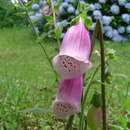Brief Summary
provided by EOL authors
Digitalis, foxglove, is a genus of 19 to 25 species of summer-blooming herbaceous perennials or biennials (rarely annuals or shrubs) in the Plantaginaceae (plaintain family) with distinctive campanulate (bell-shaped) flowers, best known as a garden ornamental and as the source of the cardiac drug digitalis, which is obtained from D. purpurea and D. lanata. Digitalis species, so named for the finger-like shape of their flower, originated in Europe, northwest Africa, and central Asia. They were formerly placed in the Scrophulariaceae (figwort family), but recent phylogenetic work has suggested a revision that would divide Scrophulariaceae into monophyletic groups, and move Digitalis into the Plantaginaceae (or in some classifications, with in the Digitalideae tribe within the Plantaginaceae). Plants in the genus generally grow a basal rosette of leaves during the first year, then develop flowering stems with alternate, simple leaves. The dwarf species D. dubia grows to 0.5 m (1.5 ft) tall, while taller species, including D. ferruginea and D. purpurea can reach 1.5 to 2 m (4 to 6 ft) in height. The showy five-parted flowers typically grow on one-sided racemes (unbranched, spike-like flower stems); in horticultural species and cultivars, the inflorescences can be densely packed with dozens of individual flowers. Flowers range in color from purple to brown, yellow, or white, often with spots or streaks inside. The medicinal compound digitalis (digitonin) obtained from Digitalis species is a cardiac glycoside that is used to treat congestive heart failure, low blood pressure, and edema. However, the effective dose is quite close to the toxic dose. The glycoside compounds found in all plant parts can be toxic to humans as well as livestock. Symptoms of toxicity include nausea and dizziness, rapid or irregular heartbeat, and hallucinations. (Bailey et al. 1976, Cornell University 2012, Olmstead et al. 2001.)

